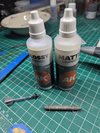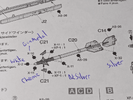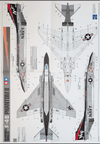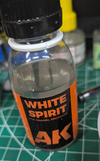F-16 "Aggressor"
- Thread starter Edbert
- Start date
urumomo
Well-Known Member
- Joined
- Mar 18, 2013
- Messages
- 7,776
You maybe sprayed the color coats on too dry ? , trying to keep the layers thin .
That will affect adhesion . The min spirits won't dissolve the acrylic but flooding the surface like that with it can delaminate the paint if it wasn't wet enough to develop a bond to the primer or other color coats .
I assume the AK white spirits is refined to " artist grade " with the removal of all the other solvents .
I'm sure it's probably priced like it is , lulz
That will affect adhesion . The min spirits won't dissolve the acrylic but flooding the surface like that with it can delaminate the paint if it wasn't wet enough to develop a bond to the primer or other color coats .
I assume the AK white spirits is refined to " artist grade " with the removal of all the other solvents .
I'm sure it's probably priced like it is , lulz
Edbert
Well-Known Member
- Joined
- May 16, 2024
- Messages
- 1,579
The use of Tamiya Acrylics (almost all "XF") is definitely new to me. I got used to heavy thinner during the 1990s-enamel era. I am 100% applying it thin, to let the pre-shade through.
Does that mean my mistake is expecting a polyurethane scale varnish? I see videos of people flowing high levels of oil-based thinner, I should have added I'm using artist-oil paints, as in meant for canvas.
Here's the product....

You can see it was even worse paint-erosion on the jamming-pod, but the sidewinder has a bulletproof enamel metallic black.
Does that mean my mistake is expecting a polyurethane scale varnish? I see videos of people flowing high levels of oil-based thinner, I should have added I'm using artist-oil paints, as in meant for canvas.
Here's the product....

You can see it was even worse paint-erosion on the jamming-pod, but the sidewinder has a bulletproof enamel metallic black.
BlackSheepTwoOneFour
Well-Known Member
- Joined
- Jun 9, 2013
- Messages
- 1,026
I'm confused… why are you using washes to weather the heck out of the finish of an Aggressor Viper for a faded look? It looked great prior to your weathering and washes.
Sidewinder tips are black, never metallic black.
Sidewinder tips are black, never metallic black.
Edbert
Well-Known Member
- Joined
- May 16, 2024
- Messages
- 1,579
The effect is much more than what I was going for, usually do not apply heavy weathering to aircraft other than Pacific War. But I had to stop wiping it off because it was stripping the paint. Can you recommend a stronger clear coat that would not get rubbed off? I thought an acrylic clear was immune to oils.I'm confused… why are you using washes to weather the heck out of the finish of an Aggressor Viper for a faded look? It looked great prior to your weathering and washes.
Sidewinder tips are black, never metallic black.
As far as the sidewinder, this is the first I've touched in about 40 years. The Tamiya instructions indicate the front portion is made up of four colors...
- White
- Chrome
- Dark Silver
- Gunmetal Black

Edbert
Well-Known Member
- Joined
- May 16, 2024
- Messages
- 1,579
My last two aircraft are jets, this is a bit of a break for me, I'm usually a WWII type. I'm trying to get out of that rut and try "new" subjects, yet the F-16 came out in the early 70s, and my Mig-21 came out in 1961 so the term new is subjective.
While I am pushing myself to build jets, I'm lying to myself in a way, seems that I cannot help but apply the heavy camo paintjobs like WWII warbirds were known for. My Phantom kit is due any day now, I'll stick to the boring grays and solid colors this time!

At least this scheme has some color! I prefer the dual-green with brown camo like Gary is building (see above, have to stop painting traditional camo!) and I wanted a shelf-mate to go with the 1968 Mig. All the F4 folks say that means F-4B, and I could not find any aftermarket decal sets for the later camo. Again, I need to stop painting camo and have not built a USN plane in more than 2 decades. The USMC F-4U does not count.

While I am pushing myself to build jets, I'm lying to myself in a way, seems that I cannot help but apply the heavy camo paintjobs like WWII warbirds were known for. My Phantom kit is due any day now, I'll stick to the boring grays and solid colors this time!

At least this scheme has some color! I prefer the dual-green with brown camo like Gary is building (see above, have to stop painting traditional camo!) and I wanted a shelf-mate to go with the 1968 Mig. All the F4 folks say that means F-4B, and I could not find any aftermarket decal sets for the later camo. Again, I need to stop painting camo and have not built a USN plane in more than 2 decades. The USMC F-4U does not count.

Last edited:
Edbert
Well-Known Member
- Joined
- May 16, 2024
- Messages
- 1,579
Do you think a lacquer clear would survive a turpentine wash?you're applying the wash with a needle hammer ?
I'm assuming I was too thin with the clearcoats, or I thinned it too much. I'm trying to wean myself from the need to use too much thinner, but the XF series of acrylics are so thick they feel like pudding! I did have nozzle drying issues without enough thinner.
On my Mig I laid down a series of coats that in total were more than 2x as thick, maybe 3x. It may be weeks but we'll see if that solves the issue.
But I have an (old) bottle of Testors Gloss Lacquer that I think might be unused, will it survive?
urumomo
Well-Known Member
- Joined
- Mar 18, 2013
- Messages
- 7,776
Turpentine is more aggressive than mineral spirits . I use it to clean spray can nozzles after use for that reason .
Cured lacquers will survive mineral spirits no problem .
A lot of " lacquers " are actually acrylic resins and not nitrocellulose , but both are safe with mineral spirits .
Cured lacquers will survive mineral spirits no problem .
A lot of " lacquers " are actually acrylic resins and not nitrocellulose , but both are safe with mineral spirits .
Edbert
Well-Known Member
- Joined
- May 16, 2024
- Messages
- 1,579
I know I could mild additives, I could thin the oils with linseed (betraying my classical experience with paints), but I do not like the idea of waiting 14 days to dry, and even then it is "mostly" dried. 30-45 days would be recommended unless you want your fingers to pull panel liner out of the grooves by touching it.
Will try to seek mineral spirits, and more coats (both might be needed) of the clear coat. Too much thinner on the color coats could be an issue too. I think I am erring on the side of too thin. Too thin is easier to recover from than too thick, but still a problem. I will keep trying and experimenting. I need to beef up part of that Mig I am working on, my XF is thinned between 50-50 maybe 60-40 with the leaning towards thin. I need to adjust, will not stop trying, but I need some test subjects instead of my builds.
I do appreciate the help, no derision on this site!
Will try to seek mineral spirits, and more coats (both might be needed) of the clear coat. Too much thinner on the color coats could be an issue too. I think I am erring on the side of too thin. Too thin is easier to recover from than too thick, but still a problem. I will keep trying and experimenting. I need to beef up part of that Mig I am working on, my XF is thinned between 50-50 maybe 60-40 with the leaning towards thin. I need to adjust, will not stop trying, but I need some test subjects instead of my builds.
I do appreciate the help, no derision on this site!
Last edited:

